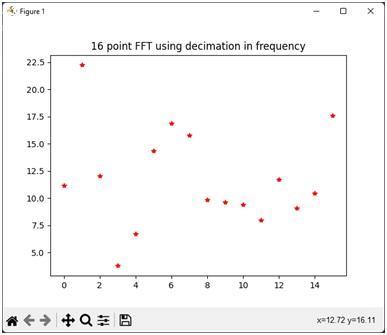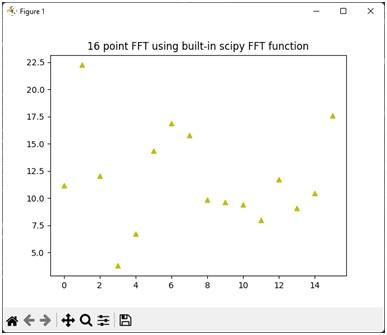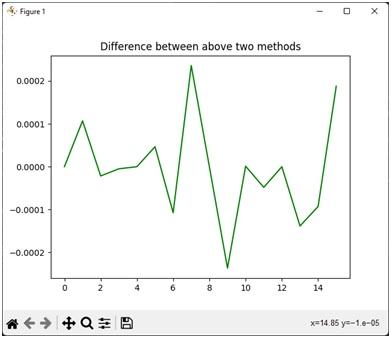Decimation-in-Frequency 16-Point FFT in Python: A Comparison with SciPy
Advertisement
This page explores the implementation of a 16-point Fast Fourier Transform (FFT) in Python using the decimation-in-frequency approach. We’ll compare this custom implementation with the built-in FFT function available in the scipy library. Decimation-in-frequency FFTs are derived by recursively breaking down the DFT calculation into smaller DFTs of subsequences of the output sequence.
Both decimation-in-time and decimation-in-frequency techniques achieve the same result but utilize different butterfly structures during computation.

16-Point FFT Python Code (Decimation in Frequency)
The following Python code implements a 16-point FFT using the decimation-in-frequency algorithm. The output is bit-reversed.
import matplotlib.pyplot as plt
import numpy as np
from scipy.fftpack import fft
# Input Coefficients
x0 = 1 + 1j
x1 = 2 + 1j
x2 = 1 - 2j
x3 = 2 - 1j
x4 = 2 + 3j
x5 = 3 + 2j
x6 = 1 + 3j
x7 = 3 + 1j
x8 = -3 + 3j
x9 = 3 - 3j
x10 = -1 - 1j
x11 = -3 - 3j
x12 = 3 - 3j
x13 = -1 - 1j
x14 = -3 - 3j
x15 = 1 + 1j
x = [x0, x1, x2, x3, x4, x5, x6, x7, x8, x9, x10, x11, x12, x13, x14, x15]
# Twiddle Factors
# 3rd stage
tc0 = 1.0000
tc1 = 0.9239 - 0.3827j
tc2 = 0.7071 - 0.7071j
tc3 = 0.3827 - 0.9239j
tc4 = 0.0000 - 1.0000j
tc5 = -0.3827 - 0.9239j
tc6 = -0.7071 - 0.7071j
tc7 = -0.9239 - 0.3827j
# 2nd stage
tb0 = 1.0000
tb1 = 0.7071 - 0.7071j
tb2 = 0.0000 - 1.0000j
tb3 = -0.7071 - 0.7071j
# 1st stage
ta0 = 1.0000
ta1 = 0.0000 - 1.0000j
# Stage 3 outputs
s3_0 = x0 + x8
s3_1 = x1 + x9
s3_2 = x2 + x10
s3_3 = x3 + x11
s3_4 = x4 + x12
s3_5 = x5 + x13
s3_6 = x6 + x14
s3_7 = x7 + x15
s3_8 = (x0 - x8) * tc0
s3_9 = (x1 - x9) * tc1
s3_10 = (x2 - x10) * tc2
s3_11 = (x3 - x11) * tc3
s3_12 = (x4 - x12) * tc4
s3_13 = (x5 - x13) * tc5
s3_14 = (x6 - x14) * tc6
s3_15 = (x7 - x15) * tc7
Stage3 = [s3_0, s3_1, s3_2, s3_3, s3_4, s3_5, s3_6, s3_7, s3_8, s3_9, s3_10, s3_11, s3_12, s3_13, s3_14, s3_15]
# Stage 2 outputs
s2_0 = s3_0 + s3_4
s2_1 = s3_1 + s3_5
s2_2 = s3_2 + s3_6
s2_3 = s3_3 + s3_7
s2_4 = (s3_0 - s3_4) * tb0
s2_5 = (s3_1 - s3_5) * tb1
s2_6 = (s3_2 - s3_6) * tb2
s2_7 = (s3_3 - s3_7) * tb3
s2_8 = s3_8 + s3_12
s2_9 = s3_9 + s3_13
s2_10 = s3_10 + s3_14
s2_11 = s3_11 + s3_15
s2_12 = (s3_8 - s3_12) * tb0
s2_13 = (s3_9 - s3_13) * tb1
s2_14 = (s3_10 - s3_14) * tb2
s2_15 = (s3_11 - s3_15) * tb3
Stage2 = [s2_0, s2_1, s2_2, s2_3, s2_4, s2_5, s2_6, s2_7, s2_8, s2_9, s2_10, s2_11, s2_12, s2_13, s2_14, s2_15]
# stage 1
s1_0 = s2_0 + s2_2
s1_1 = s2_1 + s2_3
s1_2 = (s2_0 - s2_2) * ta0
s1_3 = (s2_1 - s2_3) * ta1
s1_4 = s2_4 + s2_6
s1_5 = s2_5 + s2_7
s1_6 = (s2_4 - s2_6) * ta0
s1_7 = (s2_5 - s2_7) * ta1
s1_8 = s2_8 + s2_10
s1_9 = s2_9 + s2_11
s1_10 = (s2_8 - s2_10) * ta0
s1_11 = (s2_9 - s2_11) * ta1
s1_12 = s2_12 + s2_14
s1_13 = s2_13 + s2_15
s1_14 = (s2_12 - s2_14) * ta0
s1_15 = (s2_13 - s2_15) * ta1
# stage 0
s0_0 = s1_0 + s1_1
s0_1 = s1_0 - s1_1
s0_2 = s1_2 + s1_3
s0_3 = s1_2 - s1_3
s0_4 = s1_4 + s1_5
s0_5 = s1_4 - s1_5
s0_6 = s1_6 + s1_7
s0_7 = s1_6 - s1_7
s0_8 = s1_8 + s1_9
s0_9 = s1_8 - s1_9
s0_10 = s1_10 + s1_11
s0_11 = s1_10 - s1_11
s0_12 = s1_12 + s1_13
s0_13 = s1_12 - s1_13
s0_14 = s1_14 + s1_15
s0_15 = s1_14 - s1_15
Y = [s0_0, s0_1, s0_2, s0_3, s0_4, s0_5, s0_6, s0_7, s0_8, s0_9, s0_10, s0_11, s0_12, s0_13, s0_14, s0_15]
# Bit reversal permutation
Y = [Y[0], Y[8], Y[4], Y[12], Y[2], Y[10], Y[6], Y[14], Y[1], Y[9], Y[5], Y[13], Y[3], Y[11], Y[7], Y[15]]
# FFT using built-in python function
Y_fft = fft(x, 16)
Y = [abs(ele) for ele in Y]
Y_fft = [abs(ele) for ele in Y_fft]
# Calculate the difference between the two methods
Y1 = np.subtract(Y, Y_fft)
# Plot the results
plt.plot(Y, 'r*') # Our 16 point FFT output plot
plt.title("16 point FFT using decimation in frequency")
plt.show()
plt.plot(Y_fft, 'y^') # Built in 16 point FFT output plot
plt.title("16 point FFT using built-in scipy FFT function")
plt.show()
plt.plot(Y1, 'g') # Difference between two outputs
plt.title("Difference between above two methods")
plt.show()
Output Plots
The script generates three plots:
- The magnitude of the FFT computed using the decimation-in-frequency algorithm.
- The magnitude of the FFT computed using
scipy.fftpack.fft. - The difference between the two FFT results.



The difference plot ideally should be close to zero, indicating the custom FFT implementation matches the scipy implementation. Small discrepancies can arise due to floating-point precision.
Advertisement
 RF
RF






